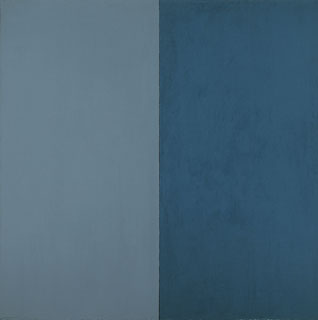|
| |
 |
|


|

Untitled, 1973. Oil and wax on canvas, two panels, overall: 72 x 72 1/8 inches. Solomon R. Guggenheim Museum, New York, Panza Collection. 91.3789
|

In the increasingly theoretical New York art world of the 1960s and 1970s, painting was displaced in favor of sculpture in a new mode that privileged concept over material, idea over sensory quality. When painting did appear, the prevailing aesthetic called for pristine, monochromatic surfaces that appeared to have been untouched by the artist's hand. Brice Marden departed from these stylistic strictures in search of something more emotionally charged and personal. His early single-color panels reconcile the stringent subtractions of Minimalism with his more expressive impulses as a painter. Upon close inspection, Marden's matte canvases, layered with thick encaustic (his characteristic oil-and-wax technique), reveal the marks of the palette knife, the subtle ridges in the viscous material inflecting each panel's uniform color and opacity with impressions of the painter's working process. This evidence, along with the artist's anachronistic tendency toward the lyrical, is what distinguishes his work from that of his Minimalist contemporaries who rely on a cool industrial quality.
Although Marden's paintings are nonobjective, he often draws upon specific people, places, or other works of art as sources. Inspired by the austere palette of the Spanish masters Goya and Zurbarán, his early paintings achieve a brooding gravity through subtle, low-key color combinations. D'après la Marquise de la Solana is a response to Goya's portrait of the Marquise that Marden saw in the Louvre. His translation of the 18th-century figure into the language of reductivist abstraction is a potent distillation of the color, light, and mood in Goya's original. Delicately worked panels of peach, gray, and olive-taupe succinctly paraphrase the Marquise's elusive expression and dainty poise in the midst of a grand romantic landscape.
|
|